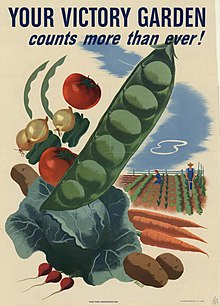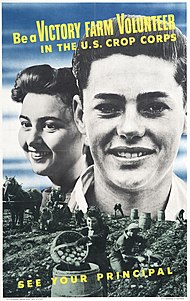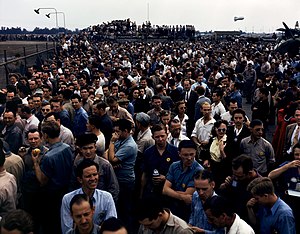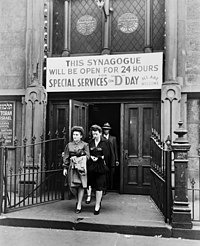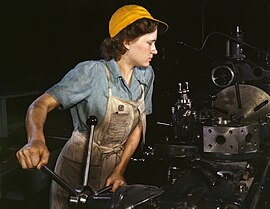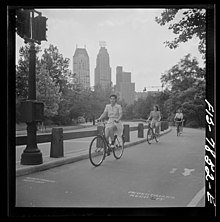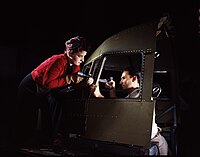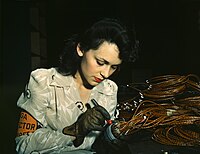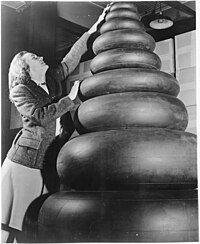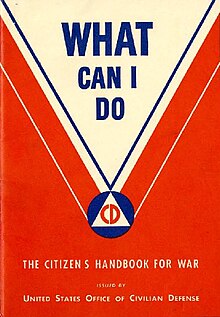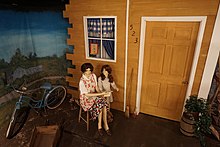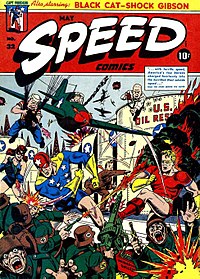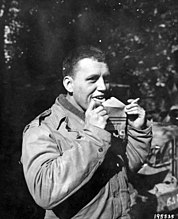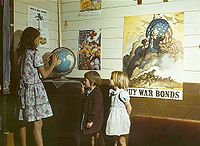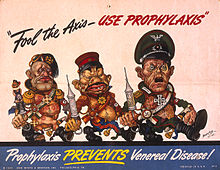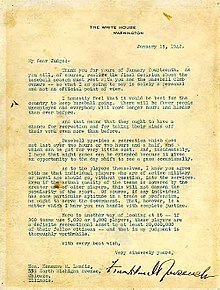United States home front during World War II
By 1943, government-issued ration coupons were required to purchase coffee, sugar, meat, cheese, butter, lard, margarine, canned foods, dried fruits, jam, gasoline, bicycles, fuel oil, clothing, silk or nylon stockings, shoes, and many other items.
Alice Throckmorton McLean founded the American Women's Voluntary Services (AWVS) in January 1940, 23 months before the United States entered the war.
When Pearl Harbor was bombed, the AWVS had more than 18,000 members who were ready to drive ambulances, fight fires, lead evacuations, operate mobile kitchens, deliver first aid, and perform other emergency services.
[26] With the war's ever-increasing need for able-bodied men consuming America's labor force in the early 1940s, industry turned to teen-aged boys and girls to fill in as replacements.
At the program's peak in 1944 there would be 903,794 volunteers which made it larger than the amount in the Women's Land Army, foreign migrant workers and the number of prisoners of war who were laborers.
Employers gave workers new untaxed benefits (such as vacation time, pensions, and health insurance), which increased real incomes even when wage rates were frozen.
[37] The war marked a time of dramatic change in the poor, heavily rural South as new industries and military bases were developed by the Federal government, providing badly needed capital and infrastructure in many regions.
"[42][43] Early in the war, it became apparent that German U-boats were using the backlighting of coastal cities in the Eastern Seaboard and the South to destroy ships exiting harbors.
The experience of World War I regarding men needed by industry was particularly unsatisfactory—too many skilled mechanics and engineers became privates (there is a possibly apocryphal story of a banker assigned as a baker due to a clerical error, noted by historian Lee Kennett in his book "G.I.")
Only a minority of religious leaders, typified by Reinhold Niebuhr, paid serious attention to the threats to peace posed by Nazi Germany, Fascist Italy, or Imperial Japan.
Although young women pacifists were not eligible for the draft, they volunteered for unpaid Civilian Public Service jobs to demonstrate their patriotism; many worked in mental hospitals.
As historian Roger Bruns notes, "the Zoot suit also represented a stark visual expression of culture for Mexican Americans, about making a statement—a mark of defiance against the place in society in which they found themselves."
[76] For example, in a Sperry Corporation recruitment pamphlet the company stated, "Note the similarity between squeezing orange juice and the operation of a small drill press."
A Ford Motor Company at Willow Run bomber plant publication proclaimed, "The ladies have shown they can operate drill presses as well as egg beaters."
In a New Deal-like move, the federal government set up the "EMIC" program that provided free prenatal and natal care for the wives of servicemen below the rank of sergeant.
In the east, however, the large Italian populations of the northeast, especially in munitions-producing centers such as Bridgeport and New Haven, faced no restrictions and contributed just as much to the war effort as other Americans.
The Fair Employment Practices Commission (FEPC) was a federal executive order requiring companies with government contracts not to discriminate based on race or religion.
It assisted African Americans in obtaining defense industry jobs during the second wave of the Great Migration of southern blacks to Northern and Western war production and urban centers.
Under pressure from A. Philip Randolph's growing March on Washington Movement, on June 25, 1941, President Roosevelt created the Fair Employment Practices Committee (FEPC) by signing Executive Order 8802.
In the private sector, the FEPC was generally successful in enforcing non-discrimination in the North and West but did not attempt to challenge segregation in the South, and in the border region, its intervention led to hate strikes by angry white workers.
During the second phase of the Great Migration, five million African-Americans relocated from rural and poor Southern farms to urban and munitions centers in Northern and Western states in search of racial, economic, social, and political opportunities.
In the Looney Tunes cartoon Tokio Jokio (aired May 13, 1943), the Japanese people are all shown to be dim-witted, obsessed with being polite, cowardly, and physically short with buckteeth, big lips, squinty eyes, and glasses.
[107] Roosevelt easily won the bitterly contested 1940 election, but the Conservative coalition maintained a tight grip on Congress regarding taxes and domestic issues.
[112] The Soldier Voting Act of 1942 would be enacted on September 16, 1942, allowing for men and women serving the country to cast an absentee ballot if they still lived in the United States.
released in January 1940 – the very first Hollywood film of any length to satirize Hitler and the Nazis[122] – nearly two years before the United States was drawn into World War II.
To facilitate the process the OWI's Bureau of Motion Pictures (BMP) worked with producers, directors, and writers before the shooting started to make sure that the themes reflected patriotic values.
Censorship would officially begin one hour after the Attack on Pearl Harbor which took place on December 7, 1941, censoring all cable, radiotelephone and telegraphic messages between the rest of the United States and Hawaii.
Many everyday commodities were vital to the war effort, and drives were organized to recycle such products as rubber, tin, waste kitchen fats (raw material for explosives), newspaper, lumber, steel, and many others.
and "Get some cash for your trash" (a nominal sum was paid to the donor for many kinds of scrap items) and Thomas "Fats" Waller even wrote and recorded a song with the latter title.
[132]: 332 Older stars such as Jimmie Foxx, Lloyd Waner, Ben Chapman, Babe Herman and Hal Trosky also found new playing opportunities and came out of retirement.
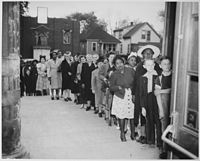
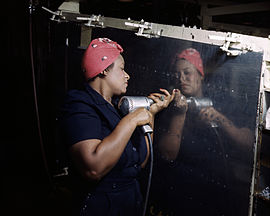

SS George Washington Carver at the Kaiser Shipyards in Richmond, California , April 1943.
